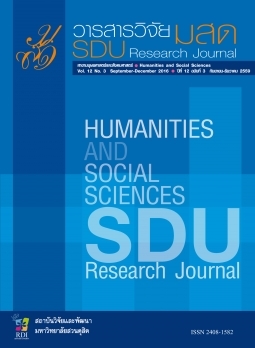การพัฒนาตัวแบบการส่งกำลังบำรุงทางทหารสำหรับปฏิบัติการบรรเทาภัยพิบัติ (อุทกภัย) ของกองทัพบก
Keywords:
Model, Military Logistics, Disaster Relief Operations, Flooding, The Royal Thai ArmyAbstract
The research objectives are 1) to study the status and problems of the military
logistics for disaster relief operations (flooding) of The Royal Thai Army (RTA) 2) to study
the factors affecting the achievements of the military logistics for disaster relief operations
(flooding) of RTA, and 3) to develop the military logistics model for disaster relief
operations (flooding) of RTA. Using mixed research methodology, survey and qualitative
research, to progress the research. The results were 1) Mitigation activities related to the
military logistics were assisting and supporting flood victims which connected to the
national preparation strategies that determining the role of armed forces as supporter.
Problems of the military logistics for disaster relief operations (flooding) of RTA were
classified to policy and management problems. 2) Factors affecting the achievements to
the military logistics for disaster relief operations (flooding) of RTA were composed of
characteristic of policy, objective of policy, resources, possibilities of theories, characteristic
of implementation entities, and intra-interrelationship of implementation entities, and
3) The military logistics model for disaster relief operations (flooding) of RTA was
developed to resolve the obstacles from the factors affecting the achievements of the
military logistics for disaster relief operations were composed of characteristic of policy
(pilot project and improvement evaluation system), objective of policy (developing specific
key performance indicators and efficiency communication), resources (amendment
obsolete laws, policies, and regulations, developing doctrines, and managing all
equipments), possibilities of theories (developing technologies), characteristic of
implementation entities (altering structure and developing relationship with other sectors),
and intra-interrelationship of implementation entities (tightly co-ordination, de-regulation
and well public relations). Furthermore, the model were specific and tangible in response
phase that linking with other implementation models systematically.
References
กองทัพบก. (2556). แผนบรรเทาสาธารณภัย กองทัพอากาศ พ.ศ. 2556. กรุงเทพฯ.
กองทัพอากาศ. (2556). แผนบรรเทาสาธารณภัย กองทัพอากาศ พ.ศ. 2556. กรุงเทพฯ.
ณัฏฐ์ กาญจนโหติ. (2557). การบริหารจัดการภัยพิบัติและค้นหาช่วยเหลือผู้ประสบภัย. กรุงเทพฯ:
ศูนย์พัฒนาหลักนิยมและยุทธศาสตร์ กรมยุทธศึกษาทหารบก.
ณัฏฐ์ กาญจนโหติ. (2558). แผนเผชิญเหตุอุทกภัยระดับจังหวัด “ลพบุรีโมเดล”. กรุงเทพฯ: ศูนย์พัฒนา
หลักนิยมและยุทธศาสตร์ กรมยุทธศึกษาทหารบก.
พร พิเศก. (2558). กองทัพบกกับภัยคุกคามรูปแบบต่างๆ. กรุงเทพฯ: ศูนย์พัฒนาหลักนิยมและยุทธศาสตร์
กรมยุทธศึกษาทหารบก.
ไพฑูรย์ เหลืองตระกูล. (2552). ความสัมพันธ์ระหว่างกิจกรรมโลจิสติกส์กับการส่งกำลังบำรุงทางทหารของ
กองทัพไทย (วิทยานิพนธ์ปริญญามหาบัณฑิต). กรุงเทพฯ: มหาวิทยาลัยราชภัฏพระนคร.
ศุภชัย ยาวประภาษ. (2557). นโยบายสาธารณะ. พิมพ์ครั้งที่ 10. กรุงเทพฯ: โรงพิมพ์แห่งจุฬาลงกรณ์
มหาวิทยาลัย.
ศูนย์พัฒนาหลักนิยมและยุทธศาสตร์ กรมยุทธศึกษาทหารบก. (2555). คู่มือราชการสนาม 1 กองทัพบก
(รส.1 - กองทัพบก). กรุงเทพฯ.
ประยุทธ์ จันทร์โอชา. (2551). กองทัพไทยกับภัยคุกคามรูปแบบใหม่. กรุงเทพฯ: อักษรข้าวสวย.
สำนักงานป้องกันและบรรเทาสาธารณภัย กรุงเทพมหานคร. (2555). แผนการป้องกันและบรรเทา
สาธารณภัย กรุงเทพมหานคร พ.ศ. 2555. กรุงเทพฯ.
ทวิดา กมลเวชช. (2556). มองหาแผนเผชิญเหตุในการจัดการภัยพิบัติประเทศไทย. รัฐศาสตร์สาร, 34(2),
250-278.
วรเดช จันทรศร. (2527). การนำนโยบายไปปฏิบัติ: ตัวแบบและคุณค่า. วารสารพัฒนบริหารศาสตร์,
24(4), 535-554.
Christopher, M. and Tatham, P. (2011). Introduction. In: Humanitarian Logistics: Meeting the
Challenge of Preparing for Responding to Disasters. Christopher, M. and Tatham,
P. (Eds.), London: KopanPage.
Glaser, B., and Strauss, A.L. (1967). The Discovery of grounded theory: Strategies for
qualitative research. Chicago: Aldine.
Guha-Sapir, D., Vos, F, Below, R. and Ponserre, S. (2011). Annual Disaster Statistical Review
2010: The Number and Trends. Brussels: CRED.
Larson, P.D. (2011). Risky business what humanitarians can learn from business
logistician - and vice versa. In: Humanitarian Logistics: Meeting the Challenge of
Preparing for Responding to Disasters. Christopher, M. and Tatham, P. (editors)
London: KopanPage.
Kovacs, G. and Spens, K.M. (2011). Humanitarian logistics and supply chain management:
the start of a new journal. Journal of Humanitarian Logistics and Supply Chain
Management, 1(1), 5-14.
McGinnis, M.A. (1992). Military Logistics: Insights for Business Logistics. International Journal
of Physical Distribution and Logistics Management, 22(2), 22-32.
Parapob, S., Suthikarnnarunai, N. and Buranaprapa, P. (2009). The Survey of Thailand’s
Military Logistics Key Performance Indicators. Proceedings of the World Congress
on Engineering and Computer Science. October 20-22, 2009, San Francisco, USA.
Pettit, S. and Beresford, A. (2009). Critical success factors in the context of humanitarian aid
supply chains. International Journal of Physical Distribution and Logistics
Management, 39(6), 450-468.
Sabatier, P.A. (1986). Top-down and Bottom-up Approaches to Implementation Research:
A Critical Analysis and Suggested Synthesis. Journal of Public Policy, 6(2), 1-26.
Thomas, A.S. and Kopczak, L.R. (2005). From Logistics to Supply Chain Management:
The path forward in the humanitarian sector. Fritz Institute: San Francisco.
Van Meter, D.S. and Van Horn C.E. (1975). The Policy Implementation Process:
A Conceptual Framework. Administration and Society, 6(4), 446-484.
Van Wassenhove. (2006). Blackett Memorial Lecture Humanitarian aid logistics: supply
chain management in high gear. Journal of the Operational Research Society,
57, 475–489.
Waterman, (Jr.) R.H., Peter, T.J., and Phillips, J.R. (1980). Structure is not organization.
Business Horizons, 23(3), 14-26.
Luangjinda, W. (2012). The Role of Military in Disaster Relief: Case Study on the
Relationship between The Royal Thai Army and Government Agencies in Flood
2011 in Bangkok (Master’s thesis) Bangkok: Chulalongkorn University.
Translated Thai References
Bangkok Fire and Rescue Department. (2012). Bangkok Flood Incident Action Plan B.E. 2555
(2012). Bangkok. (in Thai)
Center for Doctrine and Strategy Development, Army Training Command. (2012). Field
Official Manual 1 of The Royal Thai Army (Ror Sor 1 – RTA). Bangkok. (in Thai)
Chan-ocha, P. (2008). Royal Thai Army and the New Threats. Bangkok: Aksorn Khaosuai
Publishing. (in Thai)
Chandarasorn, V. (1984). Policy Implementation: Model and Value. Public Administration
Journal, 24(4), 535-554. (in Thai)
Kamonwet, T. (2013). Searching for Incident Action Plan in Disaster Management in
Thailand. Political Science Journal, 34(2), 250-278. (in Thai)
Kanchanahoti, N. (2014). Disaster Management and Victim Rescue. Bangkok: Center for
Doctrine and Strategy Development, Army Training Command. (in Thai)
Kanchanahoti, N. (2015). Provincial Incident Action Plan “Lop Buri Model”. Bangkok: Center
for Doctrine and Strategy Development, Army Training Command. (in Thai)
Lueangtrakun, P. (2009). The Relationship between Logistics Activities and Military Logistics
of The Royal Thai Army (Master’s Thesis). Bangkok: Phranakhon Rajabhat
University. (in Thai)
Ministry of Defense. (2011). Ministry of Defence Disaster Relief Plan B.E. 2554 (2011).
Bangkok. (in Thai)
Phisek, P. (2015). The Royal Thai Army And The New Threats. Bangkok. Center for Doctrine
and Strategy Development, Army Training Command. (in Thai)
Royal Thai Air Force. (2013). Royal Thai Air Force Disaster Relief Plan B.E. 2556 (2013).
Bangkok. (in Thai)
Royal Thai Army. (2013). Disaster Relief Plan B.E. 2556 (2013). Bangkok. (in Thai)
Yavaprabhas, S. (2014). Public Policy (10thed). Bangkok: Chulalongkorn University Press.
(in Thai)








